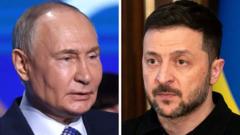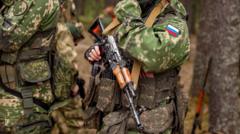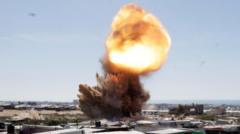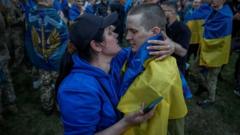A series of high-level diplomatic talks involving the US, Ukraine, Russia, and European nations aim to establish a ceasefire in Ukraine, but deep disagreements over territorial and security issues complicate the situation. While Ukraine remains steadfast in its territorial claims, Russia's preconditions present hurdles, indicating that substantial work is still required before any agreement can be reached.
Unclear Path to Ceasefire in Ukraine Amid Intensified Diplomatic Talks
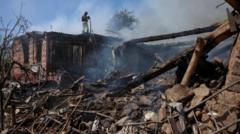
Unclear Path to Ceasefire in Ukraine Amid Intensified Diplomatic Talks
The United States is ramping up efforts to negotiate an end to the war in Ukraine, but with significant obstacles remaining, the prospects for success appear uncertain.
The pace of diplomacy surrounding the Ukraine conflict is accelerating as officials from the US, Ukraine, and European nations engage in talks aimed at reaching a ceasefire. Recent discussions in London have brought together representatives from the UK, Germany, and France alongside Ukrainian and US delegates, signaling a collaborative approach to ending the ongoing hostilities. Donald Trump's special envoy, Steve Witkoff, is also scheduled for his fourth meeting with President Vladimir Putin in Moscow. Despite these intensified efforts, there remains a significant lack of clarity regarding the likelihood of success.
At a previous juncture, the American approach to the war's resolution was more straightforward, advocating for an unconditional ceasefire over a fixed 30-day period, which would be followed by discussions on a permanent resolution. Ukraine was persuaded, under pressure from the US, to concede its demand for long-term security guarantees before halting hostilities. However, Russia countered these overtures with firm conditions, claiming that a ceasefire could only come if the foundational issues of the war were addressed. Key among these is Russia's apprehension about NATO's expansion and its perception that Ukraine's sovereignty poses a danger to national security.
The US has since adopted aspects of Russia's narrative in crafting a potential ceasefire proposal. Reports suggest that the outlined framework would involve Russia ceasing its offensive along current lines while relinquishing aspirations to control remaining parts of eastern Ukraine, specifically the territories of Luhansk, Donetsk, Zaporizhzhia, and Kherson. In exchange, the US would recognize these territories as de facto under Russian control and grant official status to Russia's claim over Crimea, which it annexed in 2014. Additionally, a crucial component of the agreement potentially includes Ukraine formally abandoning its quest for NATO membership.
Questions also surround the management of the Zaporizhzhia nuclear power plant, which is currently under Russian oversight; the proposal might see the US taking control of it to supply electricity to both Ukrainian and Russian-controlled regions. However, Western diplomats acknowledge that various aspects of this proposal face scrutiny. Amid the ongoing conflict, President Volodymyr Zelensky of Ukraine has expressed firm resistance to conceding Crimea, highlighting the necessity of a referendum with the Ukrainian public before any territorial agreements can be reached. European leaders have echoed similar sentiments, emphasizing that Russian sovereignty over Crimea would violate the principles of post-war international law.
Some diplomatic sources remain cautiously optimistic about the potential for agreement. One official remarked that there might be "landing space" for negotiations if enough trust can be fostered between the involved parties. Nonetheless, many critical gaps persist in the proposed deal. Notably, there's a lack of references concerning the continuation of military aid to Ukraine—a primary concern for Russia—and no clear strategy regarding Ukraine's military capabilities in the future.
Moreover, while the proposed framework restricts NATO membership, it does not hinder Ukraine's aspirations to join the European Union, suggesting there remains scope for EU partnership. The possibility of a European "reassurance force" deploying to Ukraine after a ceasefire also hangs in the balance, with uncertain support from the US in this venture.
Ultimately, significant details surrounding economic sanctions and their potential lifting remain unresolved, underscoring the complex and multifaceted nature of negotiations. The contrasting positions between Ukraine, eager for an immediate conditional ceasefire, and the US approach focusing on swift outcomes create a challenging landscape. Russia, for its part, seeks a comprehensive peace agreement—a process that typically unfolds over extended periods. In this context, the old Russian adage rings true: “nothing is agreed until everything is agreed,” illustrating just how much work lies ahead.










